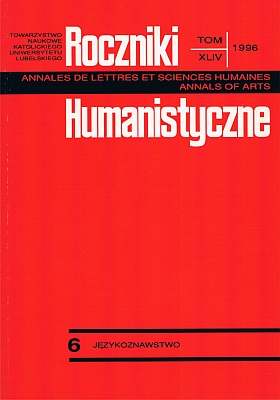Kazania augustiańskie nie są zabytkiem małopolskim
Abstrakt
In the work on Polish dialectisms contained in the manuscripts of the beginning of the 14th century Maria Bargieł included Augustine Sermons into Little Poland monuments, although she gave no arguments motivating this localization.
In this paper the author presents some facts which make it impossible to include those manuscripts within the monuments from Little Poland, and quotes some phenomena which provide grounds to localize the language of the Sermons in time and space. We find here: 1. the Mazury speech, 2. hard ky gy, ke (dat. and acc. sing. masc. and neutr.), 5. the prepositions w and z before the words with initial w- and z- (there is no pronunciation we wodzie ze sokiem). We have to add here two of those mentioned by M. Bargieł: 6. nasal vowels, short and long, with synchronous nasality (marked by the letter ą, rarely the letter a) and 7. the pronoun się (no records with mię and cię) with nasality with both verbs and after the preposition za (there is only zasię). The phenomena, whose existence in the Sermons may be questioned, are the following: 8. the pronunciation of śfąty (with the nasal a), śfat, ćferć etc., 9. a tendency to shift from y to i, and along with it 10. the pronunciation of li as ly, e.g. malyna, Lublyn, and 11. the ending instr. plur. -my (aside to -mi), e.g. nogamy (aside to nogami).
The above phenomena occur in the Masovian monuments (and in today local dialects). The writer of the Sermons came from Masovia, strictly speaking that part of Masovia situated east of the Vistula.
The Sermons were written in the second half of the 15th century, most certainly right before its end. The writer preserved the old difference between the instrumental and the locative singular in masculine declinations and neutral pronouns and adjectives; this difference is rarely recorded in the 16th-century texts. As to the late occurrence of the accusative form go in the Warsaw records: they could have been used by the court scribe as late as 1494. The preacher, however, who dealt with a careful, artistic language - since the language of sermons should be regarded as such - undoubtedly knew that literary form much earlier. The monument distinguishes itself with a very careful spelling, rarely encountered in the fifteenth century.
Copyright (c) 1996 Roczniki Humanistyczne

Utwór dostępny jest na licencji Creative Commons Uznanie autorstwa – Użycie niekomercyjne – Bez utworów zależnych 4.0 Międzynarodowe.





